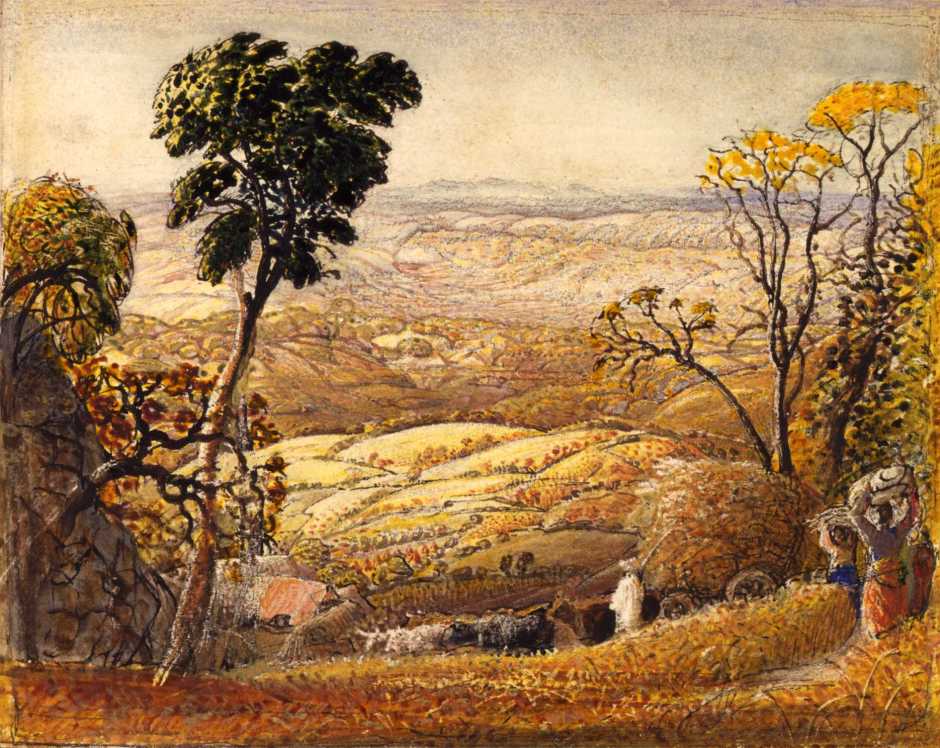What could be more characteristic of the landscape in northern Europe than a patchwork quilt of fields marked out by hedgerows?

This is shown well in Samuel Palmer’s view of The Golden Valley from about 1833-4, an open panorama looking over Underriver, near Sevenoaks in Kent, as an oxcart descends into the valley from rolling downland.

Even in the flatlands of the Netherlands, seen in Philip de Koninck’s Panoramic Landscape With a City in the Background (1655), a rhythmic series of treed hedges recede to distant dunes.

In Millet’s The Hamlet of Cousin near Gréville (1855), the artist has returned to the hamlet of his birth, and shows the rough lane leading to another nearby hamlet, Cousin. This rolling countryside with hedgerows enclosing tiny fields contrasts with that around Barbizon, where he painted more usually.

John Brett’s superb view of Caernarvon appears to have been completed in front of the motif during October 1875. It shows how cultivated lowlands are densely hedged, while the steeper slopes remain open land for summer grazing.

Towards the end of the First World War Sir William Nicholson moved to Harlech, a picturesque small town on the coast of North Wales. His view from The Hill above Harlech, painted in about 1917, shows Harlech Castle below, and looks across the broad sweep of sand in Tremadoc Bay towards the distant Lleyn Peninsula. Much of this land is divided up into small fields by well-maintained hedges.

Eric Ravilious is best-known for his landscapes of the south of England, particularly the South Downs in East Sussex. At some time in 1928 he travelled to the Welsh border, where he painted this Wet Afternoon with View of the Church of St Mary, Capel-y-ffin, Powys (1928). This tiny village is about eight miles from Hay-on-Wye, and like much of this area its roads and tracks are lined by high hedges.
In reality, such regular boundary hedges are relatively recent. Look back to views painted before the land became enclosed, and hedges are more unusual.

Thomas Gainsborough’s Wooded Landscape with a Peasant Resting from 1747, one of his finest landscapes, shows the flat countryside of Suffolk, England, which only forms into hedged fields in the middle distance, where the trees and bushes have been cleared to make way for its cultivation.

John Crome’s Mousehold Heath, Norwich (c 1818-20) shows the low rolling land to the north-east of the city that had remained open heath and common land until the late eighteenth century. By 1810, much of it had been enclosed, and ploughed up for agriculture. Crome opposed the enclosure of common land, and here shows the rich flora, free grazing, and – for the plains of East Anglia – rolling countryside. In the right distance some of the newly created farmland is visible as a contrast.

As with other countries in Europe, Danish farmland had been progressively enclosed by hedges and fences during the late eighteenth and nineteenth centuries. Laurits Andersen Ring’s Fenced in Pastures by a Farm with a Stork’s Nest on the Roof from 1903 may therefore deliver social commentary on the continuing issues of enclosure and land reforms.

Other landscapes remained devoid of hedgerows. During the 1930s, Eric Ravilious started spending time in Sussex, where he and his wife became close friends with Peggy Angus, whose house The Furlongs at Beddingham, East Sussex, became their second home. He became particularly fond of painting the chalk downs there, as in his Windmill (1934), where a few barbed-wire fences mark its boundaries, and the only hedges visible are on the flatlands in the left distance.
Although today’s campaigns to bring back hedges to the landscape are commendable for their ecological benefits, for many areas across northern Europe they are merely returning fields to a temporary state that resulted from the enclosure of common land that occurred in the eighteenth century.

